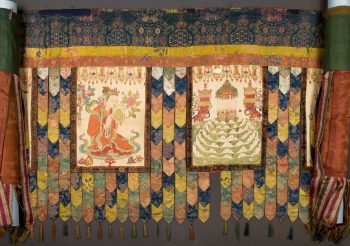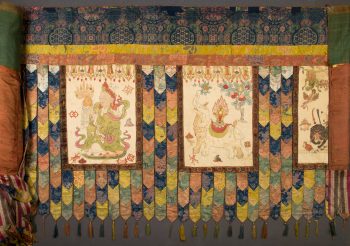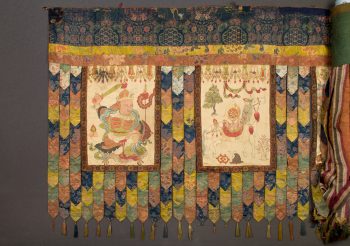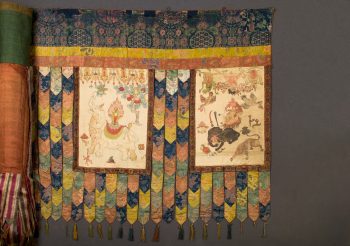Tibet
19th century




Tibet
19th century




This horizontal banner is part of a Tibetan Buddhist temple decoration that is usually hung by the rafters high along the wall. It depicts the Seven Attributes of Royal Power, or the symbols of a universal monarch (Sanskrit: chakravartin)—a wheel, jewel, queen, minister, elephant, horse, and general. They are also part of the offerings invoked during Buddhist rituals, including mandala offerings.The banner is made up of seven pieces of cream-colored silk, which may have faded from an original golden color. Five of the panels feature the symbols described above and the remaining two depict Mount Sumeru (central panel) and wrathful offerings (far right). It is possible that there was another, now-missing section that continued after the image of the wrathful offerings or that there was another banner made in the same convention that contained other auspicious symbols and decorated the opposite wall.The seven panels are separated by multicolored silk segments (usually five colors) that overlay each other and have tassels made of silk threads attached to the lower edges of the hanging. The panels and the multicolored segments are attached to a three-colored silk band that is used to attach the banner to the wall or a wooden rafter. The back of such banners are usually lined with cotton, as is the case here. Their edges also usually have running piping. This example has a hemp rope that serves this purpose. The back of the banner contains the inscription “nub byang thur ‘tshams,” which translates to “northwest juncture” or “corner,” where it might have hung.
A kind of energy that can be used, individually and collectively, to effect change.
Prescribed practices that carry symbolic meaning and value within a specific tradition and are intended to attain a desired outcome. Rituals are usually done as part of a ceremony or regular routine.
Today, Tibetans primarily inhabit the Tibetan Plateau, situated between the Himalayan mountain range and the Indian subcontinent to the west, Chinese cultural regions to the east, and Mongolian cultural regions to the northeast. During the 7th to 9th century, Tibetan rulers expanded their empire across Central Asia, and established Buddhism as the state religion.
Get the latest news and stories from the Rubin, plus occasional information on how to support our work.